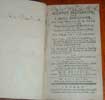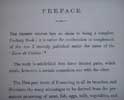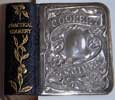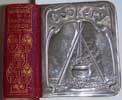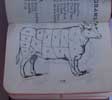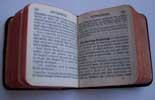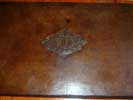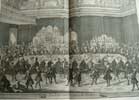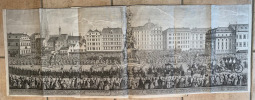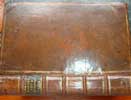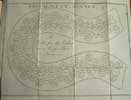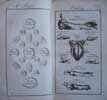Rundell.
Mrs
- A rare second edition - 1st issue.
A NEW SYSTEM OF DOMESTIC COOKERY;
FORMED UPON PRINCIPLES OF ECONOMY. And adapted to the Use of PRIVATE FAMILIES. BY A LADY. A NEW EDITION, CORRECTED. LONDON: PRINTED FOR JOHN MURRAY, FLEET-STREET; J.HARDING, ST.JAMES'S-STREET; AND A.CONSTABLE AND CO. EDINBURGH; At the Union Printing-Office, St.John's Square, by W.Wilson. 1807. Price Seven Shillings and Sixpence.
Small 12mo. 2nd edition - 1st issue. (The second issue has considerably more pages) 2feps. [1] Frontispiece. Title page. [1] (Entered at Stationers Hall) 1p Advertisement. 1p Directions to Binder. p18 Contents. 1-xxx Miscellaneous Observations with seven plates of carving meats. 1+2-323. [1] 1+326-351. 3p Advertisements. 2feps. Half crushed dark tan calf spine and corners with marbled boards. Spine with raised bands, gilt tooling and lettering. Original uncut paper edges. Internally, slightly dusty but overall very clean. A very nice copy.
-
Maria Rundell was the original ‘domestic goddess.’ An elderly Edinburgh widow whose best-selling book on cookery, medicinal remedies and household management defined the perfect home. ‘A New System of Domestic Cookery’ was a publishing sensation in the early 1800s. It sold half a million copies and conquered America, and its profits helped found one of the Victorian era's most influential Edinburgh based publishing empires, one which boasted Lord Byron, Charles Darwin, Sir Walter Scott, Jane Austen, Benjamin Disraeli and Arthur Conan Doyle among its authors.
Nearly 180 years after her death, the National Library of Scotland in Edinburgh holds one of the most significant single collections of papers on 19th century literature. The ‘John Murray Archive’ compiled by the seven generations of Murrays, was recently bought by the library, for the staggering sum of £31,000,000, chiefly with lottery money. It includes 150,000 pages of letters, manuscripts and documents from some of the most significant thinkers, scientists and writers of modern history.
Scholars have largely ignored Mrs Rundell, a friend of the Murrays and the widow of a surgeon from Bath, and overlooked her remarkable role in the company's success - a success soured by a bitter feud. In 1805, aged 61, she had sent the second John Murray, the son of the Scottish printer who set up a small publishers in London in 1768, an unedited collection of recipes, remedies and advice on running a home. She had compiled it originally for her seven daughters, and offered it to Murray free of charge. Murray recognised its potential. It was some 60 years since the first English cookery book had been written by Hannah Glasse, and Mrs Rundell's 'New System of Domestic Cookery, Formed upon Principles of Economy and Adapted to the Use of Private Families by a Lady', was about to become the bible for Britain's 19th century bourgeoisie.
The Oxford Dictionary of National Biography describes it as "the earliest manual of household management with any pretensions to completeness, it called forth many imitations".
Stored in a double-locked 'cage' in the library's vault, Murray’s firm's 'subscriptions book' for November 21 1805 reveals advance sales of 310 copies. In July 1807 booksellers placed advance orders for 1,150 copies for this edition. By 1841 it had run to 65 British editions, selling 10,000 copies a year. It was snapped up in Britain's colony, America, where it was retitled "American Domestic Cookery and The Experienced American Housekeeper" and there ran to 37 editions, and was translated into German.
It sold more than 245,000 copies in the UK, remaining in print until the 1880s. Its profits enabled Murray to buy one of the most famous addresses in literature - 50 Albemarle Street, Mayfair. Doubling up as the publisher's offices and home, Albemarle Street's drawing room became the location for some of the most influential gatherings in 19th century English literature. Murray's guests would include Isaac Disraeli, father of the future Prime Minister, George Canning, a Foreign Secretary and briefly Prime Minister, Sir Walter Scott and Lord Byron. The poet was one of Murray's biggest signings.
The archive reveals that Mrs Rundell and her publisher soon fell out. In 1807, the year of this edition on offer, the author wrote angry letters about errors in the new edition. She said: "I am hourly struggling against my feelings, but they are grievously wounded." It had been "miserably prepared". Corrected editions soon appeared, but by 1814 their relationship had collapsed.
Convinced Murray was neglecting her book, she offered a revised version to a rival, Longmans. They issued injunctions against each other. Mrs Rundell prevented Murray from republishing the book after his rights expired. Murray blocked her rival version, rightly claiming he had improved and "embellished" the book. Their battle ended in 1821, when the Lord Chancellor cancelled both injunctions and asked them to settle privately. In February 1823 a legal agreement records that Murray paid her "the sum of two thousand and one hundred pounds of good and lawful money". Later, Mrs Rundell moved to Lausanne, Switzerland, where she died in 1828, aged 83. It was only then that her authorship was revealed.
Online, at auction, in dealer’s catalogues and in book shops, later editions by Rundell are numerous and very common. We are informed erroneously in some bibliographies, that this 1807 copy is the rare first edition. In fact the first was published 1805/1806 in a very small number. This copy is the equally scarce second edition, of which only a little over a thousand copies were published. This is an exceptionally clean, untrimmed copy; A real collectors item.






|
|

Antiquarian category
ref number:
11042
|
